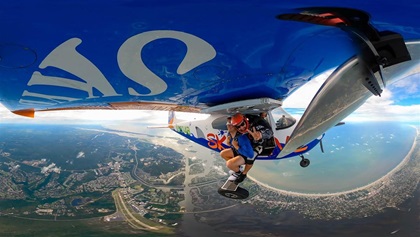Jump pilots score ‘win-win’
Plenty of flight time, satisfied skydivers

“I like the win-win that’s going on,” said Jumpers Away skydiving pilot school founder Ed Scott, of Cape Fear Regional Jetport/Howie Franklin Field in Oak Island, North Carolina. “The skydiving crowd is one big welcoming family, and jump pilots become a part of it. The commercial pilot is getting a win because he or she is getting a job at under 500 hours total time, putting flight time in their logbook, and getting paid.” Pilots consider it a fun but demanding role, and gain practical experience for additional aviation opportunities.
Scott began skydiving during college and was intrigued by the pilots of a modified Cessna 182 containing four jumpers, a pilot, and little else. The aircraft is stripped of all interior niceties except the left seat. Gymnastic pads and seat belts secure skydivers to the aircraft floor.
After pursuing his instrument rating and commercial certificate, Scott was hired as a weekend drop zone pilot. He praised the opportunity for providing him with “a lot of flight time, a little bit of pay,” and a thriving aviation environment.
Parachute-wearing pilots carry one to four skydivers per 30-minute Skylane jump run, expediting them to 11,000 feet for a freefall exit. A quick, circling descent to the runway ensues before the process begins again.
“I got maybe an hour of ground school, then I went up and did one simulated jump flight before I was handed the keys and told to ‘start flying jumpers.’ There was a lot I didn’t know,” he said.
He took a position with the U.S. Parachute Association after college. Learning of a skydiving tragedy spurred Scott to improve jump pilot training. “It was a brand-new jump pilot and there were several fatalities, so that stuck with me for years.”
“It feels good to see people enjoying themselves skydiving, but what makes me feel better is knowing I’ve given them a safe, professional flight to altitude. And to me, that’s the most satisfying part.”

 Qualifications: Commercial pilot certificate, 500 hours total time. Insurance may have additional requirements.
Qualifications: Commercial pilot certificate, 500 hours total time. Insurance may have additional requirements.

